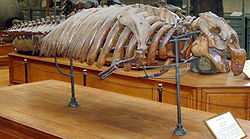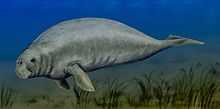Halitherium
| Halitherium Temporal range: Late Eocene–Early Oligocene | |
|---|---|
 | |
| Halitherium schinzi skeleton, Muséum national d'Histoire naturelle, Paris | |
| Scientific classification | |
| Kingdom: | Animalia |
| Phylum: | Chordata |
| Class: | Mammalia |
| Order: | Sirenia |
| Family: | Dugongidae |
| Subfamily: | †Halitheriinae |
| Genus: | Halitherium Kaup, 1838 |
| Species | |
| |
Halitherium was an early sea cow that started in the late Eocene, then the Oligocene. Its fossils are common in European shales. Inside its flippers were finger bones that did not stick out. Halitherium also had the residues of back legs, which did not show externally. However, it did have a basic femur, joined to a reduced pelvis. Halitherium also had elongated ribs, presumably to increase lung capacity to provide fine control of buoyancy.
Classification
Halitherium is the type genus of the subfamily Halitheriinae, which includes the well-known genera Eosiren and Eotheroides and lived from the Eocene to the Pliocene.[1]
Taxonomy

The genus Halitherium has had a confusing nomenclatural history.[2] It was originally coined by Johann Jakob Kaup on the basis of a premolar from the early Oligocene (Rupelian) of southern Germany, but Kaup himself mistakenly stated that the premolar, in his opinion, gehort zu Hippopotamus dubius Cuv., unaware that H. dubius is actually a junior synonym of the primitive sirenian Prototherium minima, while simultaneously coining the genus and species name Pugmeodon schinzii for the same specimen.[3] For his part, the renowned German paleontologist Christian Erich Hermann von Meyer included the type specimen of Halitherium schinzii in his composite species Halianassa studeri,[4] whose hypodigm also included the type specimens of Metaxytherium medium and Protosiren minima as well as a Miocene-age maxilla and a skeleton from the molasse basin in Switzerland.[5][6] Later, Kaup synonymized Pugmeodon with Halitherium creating the new combination Halitherium schinzii, and the name Halitherium became universally accepted for the early Oligocene halitheriine material from Europe.[7] Because Halitherium was originally based on a misidentified type species and due to the widespread use of Halitherium, the sirenian specialist Daryl Domning petitioned the ICZN to designate Pugmeodon schinzii as the type species of Halitherium, and the proposal was approved by the Commission in 1989, effectively making Pugmeodon a junior objective synonym of Halitherium in line with the current concept of Halitherium introduced by Kaup himself.[8][9]
Apart from H. schinzii, there have been five other species of Halitherium that have considered valid in recent papers: H. alleni,[10] H. antillense,[11] H. christolii,[12] H. bellunense,[13] and H. taulannense.[14] However, the latter three species appear to represent distinct, unnamed genera, while H. antillense is a nomen dubium, leaving H. alleni the only species that can be safely considered congeneric with H. schinzii. Complicating matters further, recent work suggests that there are two species lumped together under the name H. schinzii, in which case the correct name for one of them would be H. bronni Krauss, 1858.[15]
References
- Notes
- ↑ D. P. Domning. 1996. Bibliography and Index of the Sirenia and Desmostylia. Smithsonian Contributions to Paleobiology 80:1-611
- ↑ D. P. Domning. 1987. Halianassa studeri von Meyer, 1838 (Mammalia, Sirenia): proposed designation of a neotype, and proposed conservation of Halitheirum Kaup, 1838 by designation of a type species. Bulletin of Zoological Nomenclature 44(2):122-125
- ↑ Kaup, J.J., 1838. [tJber Zahnen von Halytherium and Pugmeodon aus Fionheim.] Neues Jahrbuchfiir Mineralogie, Geologic und Paldontologie, 1838: 318-320.
- ↑ Meyer, H. von. 1838. [Letter to H. G. Bronn.] Neues Jahrbuch für Mineralogie. Geologic und Paläontologie, 1838: 667-669.
- ↑ Studer, T. 1887. Ueber den Steinkern des Gehirnraumes einer Sirenoide aus dem Muschelsandstein von Wiirenlos (Kanton Aargau), nebst Bemerkungen iiber die Gattung Halianassa H. von Meyer und die Bildung des Muscheisandsteins. Abhandlungen der Schweizerischen Paldontologischen Gesellschaft, 14(3): 1-20.
- ↑ Duvernoy, G. L. 1835. Plusieurs notes sur quelques ossemens fossiles de I'Alsace et du Jura. Memoires de la Societe du Museum d'Histoire Naturelle de Strasbourg, 2 Mem. GG: 1-12.
- ↑ Kaup,J.J.1855.BeitraegezurnaeherenKenntnissderurweltlichenSaeugethiere, vol.2,1-23pp. Darmstadt.
- ↑ Domning, Daryl, 1987. Halianassa studeri von Meyer, 1838 (Mammalia, Sirenia): proposed designation of a neotype, and proposed conservation of Halitherium Kaup, 1838 by designation of a type species. Bull. Zool. Nomencl. 44(2): 122-125.
- ↑ International Commission on Zoological Nomenclature, 1989. Opinion 1535: Halianassa studeri von Meyer, 1838 (Mammalia, Sirenia): neotype designated; and Halitherium Kaup, 1838 (Mammalia, Sirenia): Pugmeodon schinzii Kaup, 1838 designated as the type species. Bull. Zool. Nomencl. 46(1): 83-84.
- ↑ Simpson GG. 1932. Fossil Sirenia of Florida and the evolution of the Sirenia. Bulletin of the American Museum of Natural History 59: 419–503.
- ↑ Matthew WD. 1916. New sirenian from the Tertiary of Porto Rico, West Indies. Annales of New York Academy of Science 27: 23–29.
- ↑ Fitzinger LJ. 1842. Bericht über die in den Sandlagern von Linz aufgefundenen fossilen Reste eines urweltlichen Säugers (Halitherium cristolii). Bericht über das Museum Francisco Carolinum Linz 6: 61–72.
- ↑ De Zigno A. 1875. Sirenii fossili trovati nel Veneto. Membro Effettivo del Reale istituto Veneto di Scienze, Lettre ed Arti 18: 1–30.
- ↑ Sagne C. 2001. Halitherium taulannense, nouveau sirénien (Sirenia, Mammalia) de l’Éocène supérieur provenant du domaine Nord-Téthysien (Alpes-de-Haute-Pro- vence, France). Comptes rendus de l’Académie des Sciences de la Terre et des Planètes 333: 471–476.
- ↑ Voss, 2013. http://edoc.hu-berlin.de/dissertationen/voss-manja-2013-11-06/PDF/voss.pdf
- Bibliography
- National Geographic Prehistoric Mammals (National Geographic) by Alan Turner
- Marine Mammals: Evolutionary Biology by Annalisa Berta, James L. Sumich, and Kit M. Kovacs
- The Beginning of the Age of Mammals by Kenneth D. Rose
- Encyclopedia of Marine Mammals by William F. Perrin, Bernd Wursig, and J. G.M. Thewissen
- Colbert's Evolution of the Vertebrates: A History of the Backboned Animals Through Time by Edwin H. Colbert, Michael Morales, and Eli C. Minkoff
- Origin of Species by Charles Darwin
- Classification of Mammals by Malcolm C. McKenna and Susan K. Bell
- The Rise of Placental Mammals: Origins and Relationships of the Major Extant Clades by Kenneth D. Rose and J. David Archibald